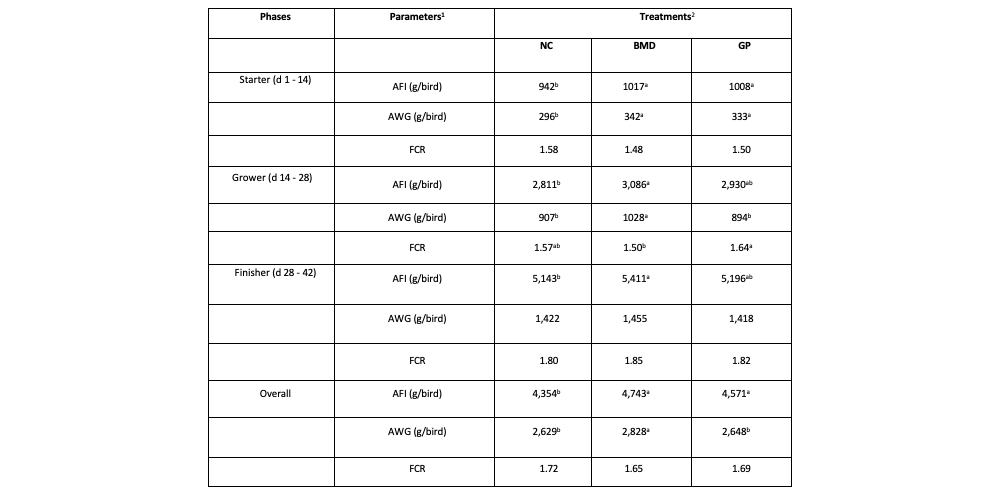


 Français
Français


The search for alternatives to antibiotics in poultry production is on-going. The use of potential feed additives is one avenue that looks promising, but it is important that they are cost- efficient and have no negative impact on meat quality. Grape pomace (GP) is a by-product in the production of grape juice and wine, which consists of the skins, seeds, and stems. It is known to be high in polyphenols which are compounds that are naturally found in plants and, when consumed, have many health benefits for the digestive tract, circulatory and muscular systems. Previous studies have used GP as a feed additive for poultry. Charmorro et. al. (2015) used supplementation rates of 5% and 10% and reported no significant improvement on growth performance of broiler chickens. Kumanda et. al. (2019) used a supplementation rate of 7.5% red GP which resulted in a reduction of overall feed intake. This study suggests that a lower inclusion rate of GP into broiler chickens’ diet could yield growth improvement, serve an alternative to the use of antibiotics, and have an impact on the occurrence of muscle myopathies in broilers, specifically, white striping (WS) and wooden breast (WB). Moreover, no study has investigated the effect of dietary GP on cecal short-chain fatty acids (SCFA), which are known to be beneficial for proper functioning of the gut.
The objective of this study was to investigate the impact of the inclusion of 2.5% dietary GP as an alternative to in-feed antibiotics, by evaluating its effect on cecal SCFA concentration and breast muscle myopathies, in addition to growth performance, blood biochemistry, and intestinal morphology of broiler chickens.
The inclusion of 2.5% GP in broiler chicken diets improved gut morphology and the proliferation of gut-friendly microbes with no adverse effect on growth performance and meat quality. These results indicate that GP may be a cost-effective alternative to the use of antibiotics.
Day old broiler chickens (Cob 500) were randomly assigned to one of three dietary treatments. The dietary treatments were as follows:
Treatment 1 (NC) – Negative control i.e., corn- wheat soybean-based diet
Treatment 2 (BMD) – NC diet plus 0.05% bacitracin methylene disalicylate (BMD) Treatment 3 (GP) – NC diet plus 2.5% GP
There were 25 birds per pen and there were 8 replicate pens per treatment. Birds were fed on a phase-feeding program as follows: starter (1 to 14 d of age), grower (14 to 24 d of age) and finisher (24 to 42 d of age). Average body weight (ABW) and average feed intake (AFI) were determined weekly on a pen basis, and mortality was recorded daily to correct for AFI and feed conversion ratio (FCR). On Day 36, two birds were randomly selected from each pen and euthanized. Blood samples were collected, weights of the empty gizzard and ceca taken, and gut morphology was examined. Breast muscle samples were collected on four birds (two males and two females) per pen on d 42 and were evaluated visually and scored by one observer for precision on the incidence of white striping (WS) and wooden breast (WB). The following parameters were determined: feed intake, body weight, body weight gain, FCR, organ weights, concentration of SCFAs, blood chemistry and gut microbiota.

References
Chamorro, S., A. Viveros, A. Rebolé, I. Arija, C. Romero, I. Alvarez, A. Rey, and A. Brenes. 2017. Addition of exogenous enzymes to diets containing grape pomace: effects on intestinal utilization of catechins and antioxidant status of chickens. Food Res. Int. 96:226–234.
Kumanda, C., V. Mlambo, and C. Mnisi. 2019. From Landfills to the Dinner Table: Red Grape Pomace
Researcher and Cooperators
Taiwo J. Erlinle, Samson Oladokun, Janice MacIsaac, Bruce Rathgeber, and Deborah Adewole
Funding
Canadian Agricultural Partnership – Advancing Agricultural Research and Innovation Initiative, Dalhousie University, MITACS and Atlantic processors (Nadeau Poultry, Country Ribbon, and Eden Valley).
The full publication of this work can be found online.
Adapted from the Atlantic Poultry Research Institute’s Factsheets
PO Box 550 Truro, NS B2N 5E3 (902) 893-6657
Laurie.Eagles@dal.ca www.APRinstitute.ca

